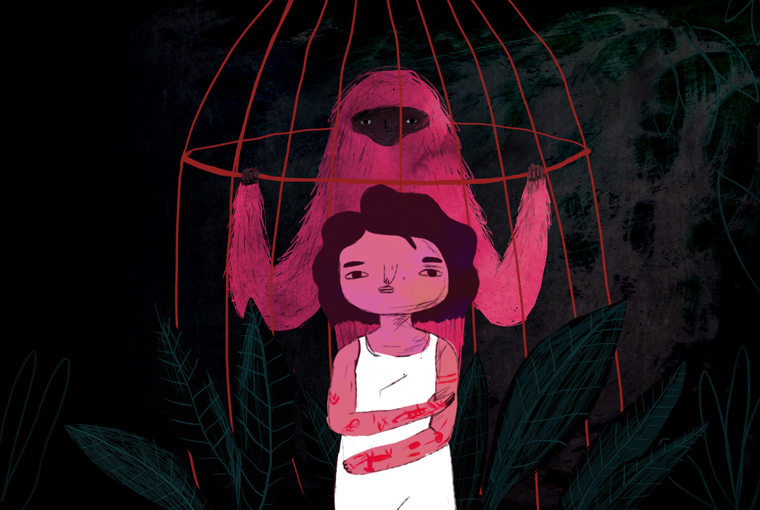Family Trauma in the Spotlight
Gyulai Panni’s Broken Things (2018) & Daria Kashcheeva’s Daughter (Dcera, 2019)
Vol. 100 (December 2019) by Melina Tzamtzi
This autumn, from October 30th until November 2nd, the 8th Primanima animation festival took place in Budaörs, a small city close to Budapest. It is a festival often described as familiar and cozy, organized by people who desire to handle modern animation films and their narratives with care. Primanima pays special attention to debut filmmakers from around the world. The festival’s aim is to welcome them to present their work and encourage them to continue creating their artistic universes. It feels like Primanima wishes to be like an open-minded and warm family that listens to, cultivates and then pushes forward its children. This aim is reflected in every aspect of the festival, which offers workshops on animation techniques and even on animation-oriented film criticism. Another interesting element of the festival is the introduction of special juries. There was a children’s film jury, a student film jury, a primAlter jury (made up by a social worker, a writer and a pedagogist), and a PrimaPsycho jury that sought out authentic representations of emotional processes.
The careful approach of the Primanima festival to animation films and their creators also left its mark on the program. The 60 short films that were selected from among 700 submissions all dealt with “real-life issues”, as Patrovits Tamas, one of the two founders of Primanima (besides artistic director Orosz Anna Ida) pointed out during the opening ceremony of the festival. For this very reason, this year the team created the section “PrimaTeen”, a selection of shorts addressing teenage audiences. After each screening of the PrimaTeen section, discussions took place (in Hungarian) which were curated and moderated by child psychologist Krisztina Peer. Indeed, many films that were screened at Primanima weren’t only “slightly autobiographical” or “based on personal events” but actual testimonies of real events that had marked their subjects. This fact asserts the great psychoanalytical capacity of animation and proves that animating personal experience seems to be of special concern to the fresh generation of animators. Many films that share this approach got awarded, such as Sister by Siqi Song, Letting Go by Cecile Brun, Broken Things by Guylai Panni and Daughter by Daria Kashcheeva.
In Broken Things, the 2D graduation film of Hungarian filmmaker Guylai Panni, the director creates a dark fairy tale to dig into her childhood trauma. We follow the story of a little girl depicted in her dark-colored and utterly silent family environment. The adults, an old woman, presumably her grandmother, and a younger one, her mother, are there, but their actual presence is dubious: their out-of-focus and melancholic looks give away their detachment from reality. In a dark variation on Alice in Wonderland, the girl tries to escape from this kingdom of loneliness by dressing it up with surrealistic elements. Notably, her grandmother starts growing leaves, slowly being transformed into a forest. A scene with a silent dinner takes place and we learn that the source of pain to this family is a big red creature with hidden eyes, the father. When he appears, the little girl quickly hides into the shadows and disappears into her personal world illustrated with vivid yet lethal colors like purple and dark red. It is a world deserted by humans where nature prevails.
Even though this world has its own ominous vibes – nature can hide, but it cannot protect (the wind shakes the thick grass as a constant warning) -, the little girl seems to find an inner peace laying there. Watching the routes of the fishes in a fountain, she feels secure. But the scenery is soon to be flustered as the monster-father walks in, his eyes painted red. She runs away and the monster is locked in a cage, screaming. The little girl then approaches and hugs the monster who eventually begins to cry, but she turns her back on it and leaves it behind, and the monster stays imprisoned. In the final scene of the film, the girl is older and the women are still there – the mother has also aged and the grandmother is totally covered in leaves, probably having receded into her own cosmos for good. The girl takes her father’s seat, everything seems better but not quite right: the monstrous red color of her father still runs inside her.
Although nothing is verbally articulated, the powerful images in which reality, fantasy and nature are entangled, communicate the diverse emotions that accompany traumas such as fear, agony, repulsion, profound sadness, and even love. Panni admits that the production of the film was traumatic all over again, but adds that it was the only way to deal with her past. What is more, the choice of the vibrant, dark colors and the minimal and haunting music, contribute in passing on the painfulness without being imposing. Indeed, the film deals with the essence of trauma without moralizing about it. It is as simple and honest as its title, stating that broken things remain broken, life goes on and art comes in between as a medicine that doesn’t pretend to heal but soothes. Broken Things got a special mention from the PrimaSound jury and the award of the PrimAlter jury.
Another short film from the Primanima selection that dealt with trauma in family relationships was Daughter, the bachelor stop-motion animation of Czech animation filmmaker Daria Kashcheeva that has already received numerous awards and special mentions. The puppet film gained two awards at Primanima, one for best graduation film and one for best sound design. Like Broken Things, Daughter is about a father-daughter relationship and about how childhood trauma attends and transforms each individual’s process of growing up. This particular relationship was marked by emotional distance that wasn’t fixed at the right time and thus led to feelings of rejection and isolation. The film begins in a hospital room. We see an old, ill man lying on a bed and a girl who watches him sleeping. Suddenly a little bird bursts inside through the window, a cathartic incident that erupts her present-time and triggers a sequence of flashbacks of her childhood years. She revisits an early incident that had defined her relationship with her father. As a little girl she had found an injured bird and had run to her father to seek consolation. Her father, not knowing how to deal with his daughter’s sudden embrace, felt himself trapped in a dilemma of what to do, prepare food or comfort her. In the end, he didn’t hug her back. Those seconds were crucial for the daughter who, like the bird, got deeply injured and started detaching from her father, physically and emotionally. The years passed and the emotional gap grew between them, with words left unspoken and useless efforts from her father’s side to finally set things right.
Kashcheeva makes the most out of the potential vitality of the puppets. The painted eyes of both daughter and father deliver their psychic states with remarkable brutality. We can feel the daughter’s inability to forgive, which has frozen her feelings towards him, and the father’s more and more desperate efforts to break the ice between them. As has already been stated, the directing is courageous in its reliance on motion, hand-held camera, and recurrent close-ups that make the spectator anxiously ask if the protagonist is finally going to find a way to forgive before it is too late. Yet it seems like every aspect of the film, the sound design, the documentary style or the art direction, is made to evoke this anxiety in order to catch the audience’s attention. Though this is not necessarily a bad thing- after all, the film belongs to the genre of drama – the film’s emotional indulgence sometimes feels forced. This is a worry worsened by the dramatic ending. The fallen bird incident breaks the girl’s emotional walls and she feels able to externalize her love for her father; she runs to catch the doctors who carry away his dead body, and she finally hugs him. Yet, despite its melodramatic shades, “Daughter” masterfully alerts us to the potential long harm that can be provoked by suppressed pain and someone’s insistence on not forgiving.




Leave a Comment